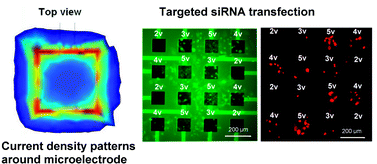Transfection of siRNA and plasmid nucleic molecules to animal, microbial and plant cell cultures is a critical process in various research areas, including drug discovery, functional genomics and basic life science research. Till recent times, transfection of these exogenous molecules have been global in nature i.e. targeting all the cells in a culture and lacking capability to spatially confine the transfection to small populations of cells within a single culture. However, in emerging areas like high-throughput screening of large molecule libraries, there is a critical need to transfect multiple different molecules to locally specified regions of a single cell culture and monitor phenotypical changes in these different cell populations. In this study, we present a cell-based biochip that utilizes a microelectrode array to generate localized current density fields that induce electroporation to a targeted group of cells for site-specific transfection of exogenous molecules. More specifically, we optimize the transfection efficiency and viabilities for spatially controlled transfection of Alexa-Fluor-488 conjugated siRNA molecules into NIH3T3 fibroblast cell cultures. Optimal electroporation parameters are established at current density values ranging between 0.05–0.07 µA µm−2 for high transfection efficiencies (>60%) while maintaining viability (>80%) on individual microelectrodes. Additionally, exogenous plasmid molecules are electroporated for site-specific GFP expression and monitored over 48 h in-situ. The microelectrode array technology reported here can therefore be potentially used for targeting specific cells in a culture with spatial precision and transfecting siRNA and plasmids. The microfabrication approach lends itself to significant high-throughput applications in drug-discovery research.

You have access to this article
 Please wait while we load your content...
Something went wrong. Try again?
Please wait while we load your content...
Something went wrong. Try again?


 Please wait while we load your content...
Please wait while we load your content...